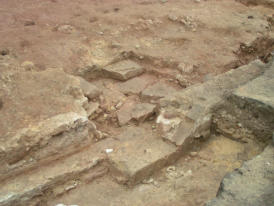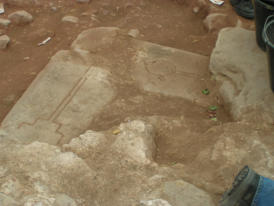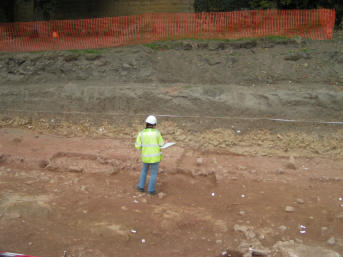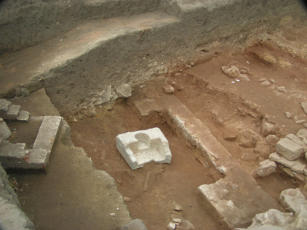


Pontefract & District
Archaeology & History Society

Looking forward…to learning more about our past
St Richard’s Friary, 2011












Our excavation found the north wall of the Friary church nave.
The wall is 75cm wide and set on a deep rock-cut foundation.
The wall was later buttressed to
bear the weight of additions,
possibly the construction of a
nave clerestory (raised upper story
above the nave with high
windows to provide additional
light into the church).
A view westwards along the north wall
of the church

We also located the east wall of the
nave north aisle, this too was later
buttressed (twice) reusing a broken
grave cover slab.
Part of an altar base survives within
the church against the whitewashed
east wall. There would have been
several altars in the church.
After the Dissolution, both of the
walls indicate that the stone had
been removed and sold, a process
known as ‘robbing’. However, we
did unearth multiple fragments and
whole pieces of stone window
tracery from one of the north wall
gothic windows, the interior faces of
which are also whitewashed.
Fragments of painted window glass
and the lead cames into which the
glass was set have been found too.
The lay cemetery lay north and east of
the church, and we found a
particularly dense cluster of graves
outside the east wall of the church
while some on the north side (e.g.,
that on the right) are almost touching
the wall.
An important find was a
rare Purbeck ‘marble’
sarcophagus, once set into
a wall niche, later pulled
out, broken open and
ransacked, the bones of
the occupant left scattered
around it.
Fragments of fine
decorative stonework,
probably from the tomb
niche décor, were also
found nearby.
The tomb had once held a
high status burial. The
sarcophagus was
imported, probably from
Purbeck in Dorset via
York.
A single burial had been cut into the demolition debris from the
church; this individual may have been a Civil War casualty from
1645-48.
A 1.5m-deep cultivation soil covered the site of the former church;
this soil was improved and manured with waste from the town
and used for the cultivation of liquorice from the C18th to the
C20th. The deep harvesting trenches can be seen in the soil
section on the northern edge of our excavation shown on the
right.
We also found a significant amount of medieval pottery, painted
window glass, clay pipes covering 400 years of history, metal
objects, animal bones, oyster shells, etc.
Information from the 2011 excavations
and from previous digs, has enabled Ron
Wilson to draw a reconstruction of what
we think the Friary site looked like in
the C15th.









Wall
buttress base
buttress base
wall
broken grave cover slab
interior of nave east wall
altar base
wall niche
north
wall of
nave

bedrock


Pontefract & District
Archaeology & History Society

Looking forward…to learning more about our past

© All text and photographs on this site are copyright. All rights reserved. Please contact the
Society for further information.



















